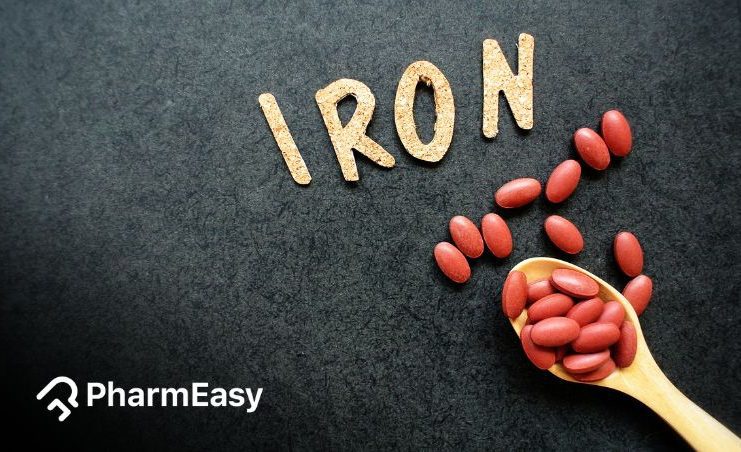Guide to Iron Deficiency Anaemia
By Saksham Bhatia +2 more

Get more insightful and
helpful tips to
treat Diabetes for FREE



Download PharmEasy App




Register to Avail the Offer
Send OTPBy continuing, you agree with our Privacy Policy and Terms and Conditions
By Saksham Bhatia +2 more
Table of Contents
Iron deficiency anaemia is a common blood disorder caused when there isn’t enough iron in the body. When there isn’t enough iron which is required to create haemoglobin, the rest of the body can’t get the oxygen it needs. While the condition is vastly prevalent, many people aren’t unaware they have iron deficiency anaemia. Even though they continue to experience symptoms, their condition can go ignored for years.

Prevalence of Iron Deficiency Anaemia In India
In India, the prevalence of anaemia in men aged 15 to 49 years is 25%, while in women of the same age group, it is 57%. As per the review conducted by the Global Burden of Diseases (GBD), it was found that iron deficiency anaemia was the main reason behind the health burden for the past decade in India. In women of reproductive age, the reason for iron deficiency anaemia was a loss of blood during menstruation, nutritional deficiencies, autoimmune disorders and certain diseases like those pertaining to the intestine.
Here, we look deeper at the symptoms, causes and treatment options for iron deficiency anaemia.
Initially, the symptom of iron deficiency anaemia can be very mild and might even go unnoticed. The best way to conclude this is to run a blood test. The moderate to severe symptoms of iron deficiency anaemia can range from fatigue to irregular heartbeat
Iron is a vital component of red blood cells. Without it, blood cannot efficiently transport oxygen to other parts of the body. The body typically repurposes iron from old red blood cells or obtains it freshly from one’s diet.
Iron deficiency anaemia develops when the iron stored in the body runs low. This occurs due to:
Bleeding causes loss of iron. The main reasons for bleeding are:
The body can be incapable of absorbing iron which can have an underlying condition:
Everyone is highly susceptible to developing iron-deficiency anaemia. Below are some risk groups for this condition:
Babies inherit their iron stores from their mothers, who carried them in their wombs for nine months, nurturing them with low nutrition. If the mother is iron deficient, the child is likely to become one, too, unless they are made to drink iron-fortified formula along with breastmilk.
Young children who only drink cow’s milk may not get sufficient quantities of iron. The child’s diet should be supplemented with fortified cow milk formula.
Growth spurts are often the reason why iron reserves end up getting exhausted quickly.
Older people do not get as much iron as needed because their meal portions tend to reduce with age.
According to healthcare providers and experts, the most effective way to diagnose iron deficiency anaemia is through blood tests and bone marrow biopsy (in some cases). The standard blood test for screening is a complete blood count (CBC). Additional tests to find out the underlying causes as prescribed by your doctor may be:
Intravenous (IV iron) and blood transfusion are some of the other treatment options if severe iron deficiency anaemia is identified in a patient.
One of the easiest ways to correct iron deficiency anaemia on a personal level is to change your diet plan. You should chart out a meal plan that focuses more on iron-rich foods. These include but are not limited to the following:
| Fruits & Vegetables | Nuts & Seeds | Meat & Fish | Beans & Pulses |
| Citrus fruits | Pistachios | Liver | Chickpea |
| Broccoli | Pine nuts | Tuna | Pinto beans |
| Red & yellow peppers | Sunflower seeds | Salmon | Black beans |
| Spinach | Hemp seeds | Sardines | Peas |
| Watermelon | Cashews | Chicken | Kidney beans |
| Pomegranate | Pumpkin seeds | Red meat | Soybeans |
| Raisins | Squash seeds | Egg | |
| Dried apricots |
Iron deficiency anaemia can become serious if it is left unaddressed for a long time. It can end up increasing your risk of developing complications that affect the lungs or heart. Further, it can cause headaches, fatigue, restless leg syndrome, pregnancy complications and developmental delays in children. The ideal way of managing iron deficiency anaemia is to follow the treatment prescribed while also consuming iron micro supplements and a diet rich in iron along with vitamin C-enriched foods that help in proper iron absorption in the body.
Disclaimer: The information provided here is for educational/awareness purposes only and is not intended to be a substitute for medical treatment by a healthcare professional and should not be relied upon to diagnose or treat any medical condition. The reader should consult a registered medical practitioner to determine the appropriateness of the information and before consuming any medication. PharmEasy does not provide any guarantee or warranty (express or implied) regarding the accuracy, adequacy, completeness, legality, reliability or usefulness of the information; and disclaims any liability arising thereof.
Links and product recommendations in the information provided here are advertisements of third-party products available on the website. PharmEasy does not make any representation on the accuracy or suitability of such products/services. Advertisements do not influence the editorial decisions or content. The information in this blog is subject to change without notice. The authors and administrators reserve the right to modify, add, or remove content without notification. It is your responsibility to review this disclaimer regularly for any changes.
Sources:
https://www.nhlbi.nih.gov/health/anemia/iron-deficiency-anemia
https://www.hematology.org/education/patients/anemia/iron-deficiency
https://pib.gov.in/PressReleasePage.aspx?PRID=1795421
https://www.nhm.gov.in/images/pdf/programmes/child-health/guidelines/Control-of-Iron-Deficiency-Anaemia.pdf
https://www.hematology.org/education/patients/anemia/iron-deficiency
Comments